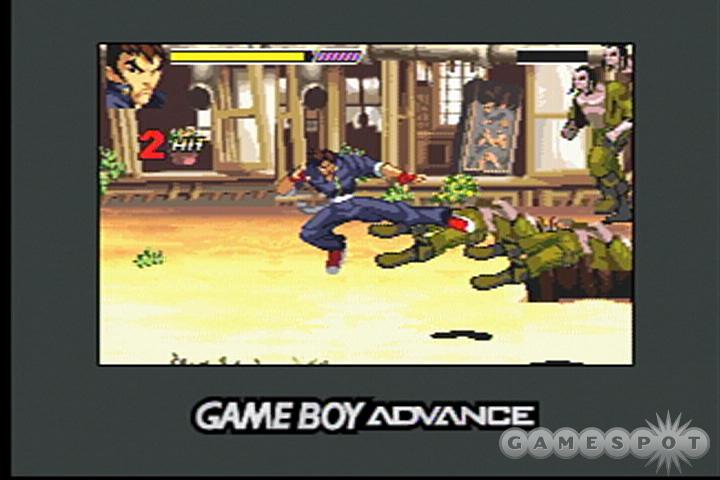Though it's been out in other territories for a while now, Gekido Advance: Kintaro's Revenge has finally been given a US release. This side-scrolling beat-'em'up is virtually identical to the European version released in 2002, but there's still a lot to like about Kintaro's Revenge, especially if you spent a great deal of time in arcades during the late '80s and early '90s. However, along with the pseudo-nostalgia and basically good combat, the game carries some significant flaws.

There's really no point going into the details of Gekido's plot--it vaguely references the events of Gekido for the PlayStation, but all you really need to know is that it's essentially fueled by the same sort of revenge that motivated the heroes of Final Fight, Double Dragon, Streets of Rage, and countless other arcade beat-'em-ups. This is fitting, seeing as how Kintaro's Revenge can easily be compared to any of these games. For the most part, you run around mercilessly whaling on thugs, zombies, bats, big Abobo knockoffs, and dudes that could best be described as just "bad guys." Tetsuo, the game's protagonist, has a black belt in beating on bad guys, and he has a respectable arsenal of punches, kicks, and throws, as well as the entirely necessary desperation move that knocks down any nearby enemies. Tetsuo is as talented a fighter as any of his predecessors, which means that the combat is simple enough to just pick up, yet varied enough to keep you engaged through the length of the game.
Where Gekido heads out on its own is with its adventure-style level designs. Instead of just walking to the right until there's no more right to be walked, you can go left, right, up, and down, flipping switches, collecting items, and doing a fair amount of backtracking. It's definitely refreshing to see Gekido take some chances with the formula of a genre bound by tradition, but in execution it can prove annoying. The background art within each level can be repetitive, which makes it really easy to get lost, especially in the game's later, serpentine-like levels. This is something that could have been easily remedied with a simple map of some kind, but as it stands, you get the sense that the developers intentionally made it confusing simply to pad out the game's length.
Getting lost may be annoying, but this is trumped by the game's plentiful and repetitive traps. There are plenty of bottomless pits and random fires scattered throughout the game, and falling rocks, various spiked things, and packs of wild dogs wait just offscreen, ready to give you a little surprise and steal some of your health in the process. Some of these traps seem to be sentient, as they'll actually wait until you're right in their path to strike. The combat in Gekido is challenging enough when you're juggling seven or eight foes at once, but when a rolling log covered in spikes, which the enemies are impervious to, comes rolling through, it just doesn't seem fair.
Tetsuo's kung fu is strong, and this is enhanced by the game's stylized animations, which is important for a game where you're fighting all the time. The game cribs shamelessly from the King of Fighters games, which really isn't so bad, if you consider how great those games looked. The quality of the animations isn't always consistent, but when they're at their best, they are simply great. A certain amount of care also went into creating the background textures, though each level pretty much takes two or three screens of background and stretches it out into an entire level. There are also some pretty good looking cutscenes, most of which focus on extreme close-ups of the characters' anime-styled faces.
The sound design is shoddy, consisting of a few punch and kick sound effects, a few different "argh" sounds for when someone gets hit, and an extremely limited music selection. There's the "calm-but-pensive walking around" music, the "dramatic cutscene" music, the "fighting a bunch of guys" music, and the "serious boss encounter" music, all of which are good in small doses but grate on the ears after a few hours of constant exposure.

In a lot of ways, Gekido Advance: Kintaro's Revenge feels less like a commercial product and more like a fan-made tribute to the genre of 2D beat-'em-ups--you can sense the enthusiasm, but the complete set of game-crafting skills isn't entirely there. The game has some great visual flair and truly satisfying combat, but it seems as though the developer didn't feel entirely comfortable with some aspects, such as the story and the audio, and just skipped over them. With just five levels, Gekido isn't long, but it's about as long as games of this caliber should be. Fans of old-school beat-'em-up games will find portions of Gekido to be simply sublime, and portions of it bitterly punishing.